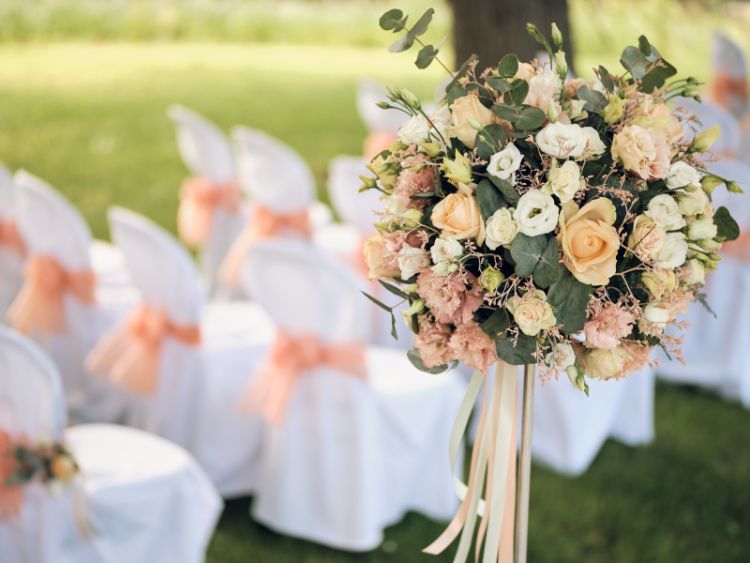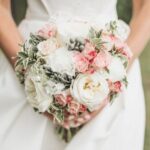When it comes to weddings, the bride’s dress often takes center stage, but the groom’s attire plays a crucial supporting role. Achieving a cohesive and elegant look between the bride and groom isn’t just a trend; it’s a testament to their unity and shared style. This article dives into everything you need to know about ensuring the groom matches the bride’s dress perfectly, without stealing her thunder.
Why Coordination Matters
The phrase “match made in heaven” doesn’t just apply to the couple—it also applies to their wedding attire! A well-coordinated look ensures:
- Visual harmony in photos and videos.
- A reflection of the couple’s shared aesthetic.
- A polished, put-together vibe for the entire wedding party.
Imagine a bride in a romantic lace gown standing next to a groom in a casual linen suit—it feels disjointed, right? Let’s break down how to avoid mismatched looks and create a seamless wedding style.
How to Match the Groom’s Suit to the Bride’s Dress
1. Start with the Bride’s Dress
The bride’s dress often sets the tone for the wedding. Here’s how to use her gown as the guiding star:
- Formality: A ballgown calls for a tuxedo, while a breezy boho dress pairs well with a more relaxed suit.
- Fabric: Satin, lace, or tulle? The groom’s attire can subtly echo the texture of the bride’s gown.
- Color Palette: While the bride traditionally wears white or ivory, the groom’s suit or accessories can incorporate complementary shades.
2. Color Coordination is Key
The groom doesn’t have to wear white, but his outfit should tie into the wedding’s color scheme. Here are a few ideas:
- Classic Matches:
- Ivory gown → Black or charcoal suit
- White gown → Navy or gray suit
- Bold Choices:
- Soft pastel dresses → Light gray or beige suits
- Jewel-tone gowns → Rich, dark suits (like emerald or burgundy)
For an extra pop of color, consider matching the groom’s tie, pocket square, or boutonniere to the bride’s bouquet.
Trends in Groom-Bridal Coordination
1. Monochromatic Magic
Couples are increasingly opting for a monochromatic palette, with the groom wearing shades of white, cream, or beige to complement the bride’s dress.
2. Mixing Textures
Pairing different textures—like a sleek satin dress with a velvet blazer—creates visual interest while staying cohesive.
3. Cultural Attire
If the couple incorporates cultural traditions, matching attire often features coordinated patterns, embroidery, or fabrics that celebrate their heritage.
Practical Tips for Perfect Pairing
1. Shop Together (Or Share Details)
While tradition dictates the bride and groom shop separately, sharing inspiration boards or color swatches can help. Grooms can also bring a photo of the bride’s dress to their fitting.
2. Focus on Accessories
Accessories are an easy way to align outfits:
- A tie or pocket square in a fabric similar to the bride’s dress.
- Matching metallic accents (gold cufflinks for the groom, gold jewelry for the bride).
- Coordinated florals—his boutonniere can mirror her bouquet.
3. Keep the Season in Mind
Seasonal factors often influence attire:
- Spring/Summer: Light fabrics like linen, pastel hues.
- Fall/Winter: Heavier fabrics like wool, darker colors.
Common Mistakes to Avoid
- Over-Matching: Coordinating doesn’t mean identical. A groom wearing a white suit next to a bride in a white gown can feel like overkill.
- Ignoring the Venue: A black-tie look might feel out of place at a rustic barn wedding.
- Neglecting Fit: Ill-fitting suits or dresses ruin even the best styling efforts. Tailoring is non-negotiable!
FAQs
Q: Does the groom’s suit have to match the bride’s dress perfectly?
A: Not at all! The goal is coordination, not duplication. Complementary colors and styles work best.
Q: Can the groom wear a different color suit?
A: Absolutely! As long as the color complements the bride’s attire and fits the wedding’s theme, it works.
Q: What if the bride’s dress is non-traditional?
A: If the bride opts for a colorful or non-traditional dress, the groom can match by pulling a color or texture from her outfit into his look.
Q: How can accessories help tie the outfits together?
A: Accessories like ties, pocket squares, and even shoes can echo the bride’s dress details, such as lace, beading, or embroidery.
Q: Is it necessary for the groom to see the bride’s dress before the wedding?
A: Not at all! Sharing a description, fabric sample, or photos of the dress can be enough for effective coordination.
Conclusion: A Stylish Union
Coordinating the groom’s attire with the bride’s dress doesn’t have to be a daunting task. By focusing on color, texture, and style, couples can achieve a cohesive look that highlights their individuality while celebrating their unity. From timeless tuxedos to creative cultural attire, the key is finding harmony in every detail.
Authoritative Links
- Wedding Style Inspiration: www.brides.com
- Groom Suit Tips: www.theknot.com
- Coordination Ideas: www.stylemepretty.com





